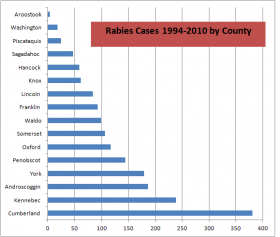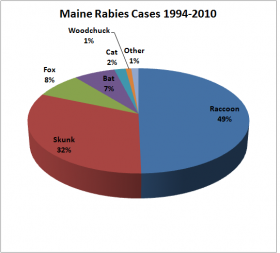What Should You do if You have been Exposed?
If you have been bitten or scratched by a wild animal, or by a pet or farm animal that has been behaving oddly, follow these steps:
1. Animals must be killed or captured without injuring the brain; brain tissue must be tested.
2. Immediately wash the wound with soap and water, continuously for at least 10 minutes.
3. Call your doctor or health care professional when you finish washing. They will help you decide if you need to be treated for rabies. Follow their instructions completely.
4. Contact your town’s Animal Control Officer. The town office, selectman, or local law enforcement can help contact him or her.
Rabies is a viral disease of the central nervous system (brain and spinal cord) that is almost always fatal. Rabies in humans is very rare in the U.S., but rabies in animals – especially wildlife – is common in some parts of the country.
Since its reintroduction in Maine in 1994, rabies from land animals has increased dramatically in Maine, especially in raccoons, skunks, woodchucks and foxes. Bats are also high risk rabies carriers.
How is Rabies Spread?
The rabies virus lives in the saliva (spit), brain, and spinal cord tissue of animals and is spread when they bite or scratch. The virus can also be spread if saliva or nerve tissue touches broken skin or a mucous membrane (in the mouth, nose or eyes).
What Animals Spread Rabies?
The rabies virus can infect any mammal (if it has fur or hair it is a mammal), but infection is most common among certain mammals such as bats, skunks, foxes, and raccoons. Rabies is very rare among rodents (squirrels, rats, mice, and chipmunks). Thanks to vaccines, rabies is extremely rare among pets and farm animals.
How can You Tell if an Animal is Rabid?
Rabid animals usually behave abnormally, but signs vary. Some animals appear shy and fearful, others become aggressive, and some may simply stumble as though drunk or appear lame. Contact with all wild animals – especially bats, skunks, foxes, raccoons, and woodchucks should be avoided.
Suspect animals, who have exposed either a human or domestic animal are tested by the Health and Environmental Testing Laboratory in Augusta.
What is the Treatment for People Exposed to Rabies?
People who have never had rabies immunizations are given a series of six injections: two on the first day and the remaining four given one at a time over the course of one month.
How can You Prevent Rabies?
Be a responsible pet owner. Make sure your pets are neutered (fixed) and vaccinated against rabies. By law, all dogs and cats must be vaccinated because they are hunters by nature and often have contact with animals at high risk for rabies. By vaccinating household pets, we can establish a buffer between wildlife and humans.
Avoid contact with wild animals, especially bats, skunks, foxes and raccoons, and woodchucks. Avoid any animal – wild, farm or domestic – that behaves oddly, and report it to the local Animal Control Officer. Discourage wild animals from “sharing your lunch”. Fasten trash can lids tightly. Garbage attracts animals like skunks and raccoons who are looking for an easy meal.
If you must handle a dead animal, use heavy gloves, sticks or other tools to avoid direct contact with saliva, neural fluid, and brain tissue. If you are bitten or scratched by an unfamiliar animal, do not try to guess if it is rabid. Call your doctor and the Animal Control Officer for advice.
Maine Animal Rabies 1994-2010 by Species and County
| County | Raccoon | Skunk | Fox | Bat | Cat | Wood- chuck |
Other | TOTAL |
| Androscoggin | 89 | 52 | 16 | 19 | 6 | 4 | 0 | 186 |
| Aroostook | 3 | 2 | 1 | 1 | 0 | 0 | 0 | 4 |
| Cumberland | 192 | 120 | 30 | 28 | 5 | 3 | 3 | 381 |
| Franklin | 50 | 24 | 14 | 3 | 1 | 2 | 0 | 93 |
| Hancock | 34 | 21 | 3 | 0 | 1 | 0 | 1 | 59 |
| Kennebec | 116 | 73 | 18 | 24 | 2 | 3 | 3 | 239 |
| Knox | 35 | 23 | 0 | 3 | 0 | 0 | 0 | 61 |
| Lincoln | 51 | 12 | 13 | 2 | 2 | 1 | 3 | 84 |
| Oxford | 45 | 39 | 21 | 8 | 2 | 1 | 1 | 117 |
| Penobscot | 88 | 46 | 2 | 4 | 3 | 1 | 1 | 144 |
| Piscataquis | 9 | 10 | 1 | 2 | 1 | 0 | 1 | 24 |
| Sagadahoc | 25 | 14 | 4 | 3 | 1 | 0 | 0 | 47 |
| Somerset | 54 | 39 | 3 | 5 | 3 | 1 | 1 | 106 |
| Waldo | 42 | 44 | 0 | 6 | 5 | 0 | 2 | 99 |
| Washington | 7 | 7 | 3 | 0 | 0 | 0 | 1 | 18 |
| York | 77 | 61 | 13 | 19 | 3 | 1 | 5 | 179 |
| TOTAL 1994-2010 | 917 | 587 | 142 | 127 | 35 | 17 | 22 | 1841 |
Source: Maine Bureau of Health, Department of Human Services



